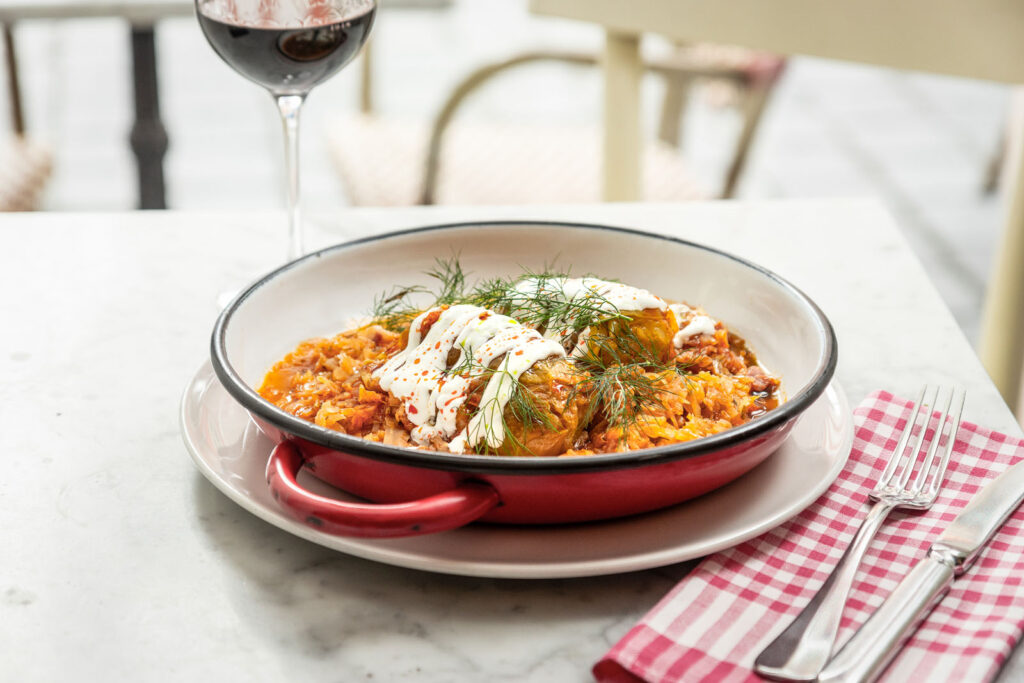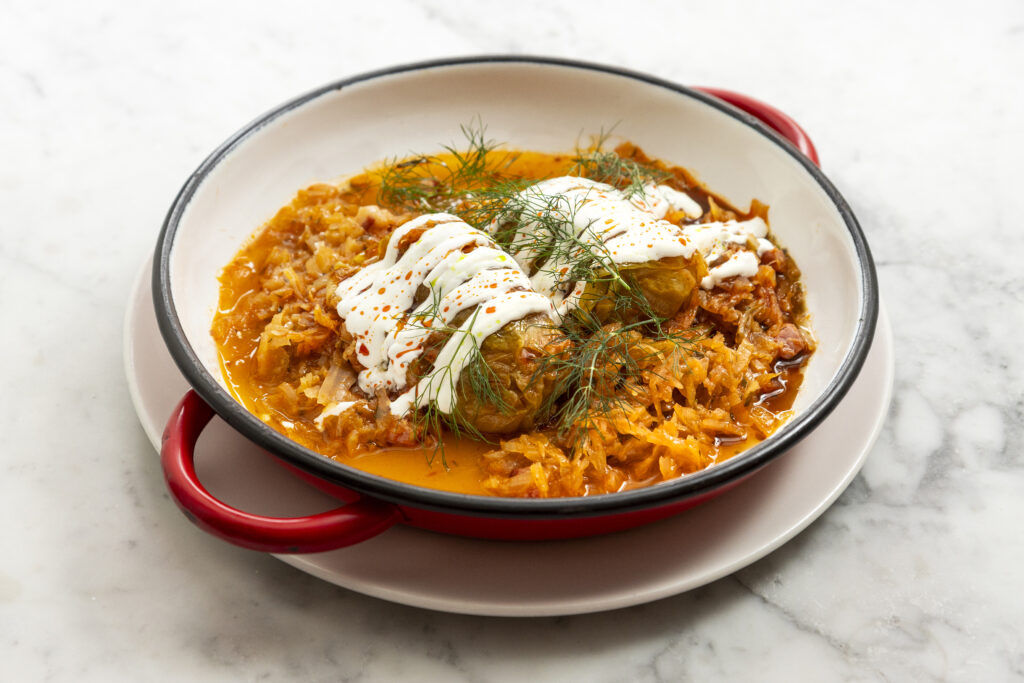In the world of culinary delights, few dishes carry the weight of memory, tradition, and comfort as profoundly as Hungarian stuffed cabbage, or as it’s called in its native tongue, töltött káposzta. Wrapped in tender cabbage leaves and simmered slowly until all the flavors have mingled into a harmonious whole, this dish is a staple of Hungarian cuisine, but also a heartfelt celebration of family, festivity, and heritage.
For the Zsidai Group — restaurants that effortlessly blend elegance with authenticity — honoring traditional Hungarian food is part of a larger mission: to create spaces where guests can both discover and rediscover the true soul of Hungarian hospitality. And when it comes to expressing that soul through food, there’s no better choice than a steaming portion of stuffed cabbage enjoyed in a cozy Buda restaurant.
What is Hungarian Stuffed Cabbage?
Stuffed cabbage is a dish defined by contrasts: soft yet structured, rich yet rustic, simple yet deeply layered. At first glance, it may seem like a humble parcel, but inside is a world of flavor.
At the heart of each cabbage roll is a seasoned mixture of minced meat and rice. The blend varies slightly depending on the region or family recipe, but the most common foundation is a combination of pork and beef. This balance between the earthiness of beef and the succulent, slightly sweet fat content of pork renders beautifully during the long, slow cooking process. The rice, far from being a filler, plays an essential role in lightening the texture and giving the rolls their signature tenderness.
The leaves — typically from savoy or fermented white cabbage — act as a vessel that holds the filling together, while also contributing their own mellow sweetness or subtle tang. Once rolled, the parcels are placed into a pot lined with sauerkraut and layered with more shredded cabbage. Then comes the magic: a rich, smoky paprika-infused tomato sauce is poured over the dish, and the whole pot is gently simmered or baked for hours.
The result is a deeply satisfying dish that embodies the very essence of warmth and welcome.

The Short History of Stuffed Cabbage
The history of this Hungarian dish is as rich and tangled as the food itself. While variations of cabbage rolls appear across Central and Eastern Europe — from Poland’s gołąbki to Romania’s sarmale — the Hungarian version has taken on a life and legend of its own.
Many food historians trace the roots of töltött káposzta back to the Ottoman era, when the Turkish empire’s culinary influence spread throughout the Balkans and into Hungary. The concept of stuffing vegetables — whether vine leaves, peppers, or cabbage — is a hallmark of Ottoman cuisine. Over time, the dish was “Hungarized,” incorporating local ingredients like pork and sauerkraut and seasoned with quintessentially Hungarian spices such as sweet paprika and marjoram.
By the 18th and 19th centuries, stuffed cabbage had become a beloved meal across Hungarian households — appearing on the tables of both aristocrats and peasants alike. It was economical, filling, and adaptable to the seasonal ingredients. It also had the advantage of being a dish that could feed a crowd, making it a fixture at weddings, family gatherings, and religious feasts.
A Taste of Home for Every Season
In Hungary, töltött káposzta is eaten throughout the year but takes on special significance during the colder months. It’s a cornerstone of the Christmas and New Year’s Eve table, believed to bring good fortune for the year to come. The slow-cooked, warming nature of the dish makes it an ideal winter comfort food, but many Hungarians would argue that there is no “wrong” time for stuffed cabbage.
In rural Hungary, it’s not uncommon for a pot of töltött káposzta to be gently bubbling on the stove while the family is out harvesting or working the land. It’s a dish that rewards patience — the longer it sits, the more the flavors deepen. Many claim that stuffed cabbage tastes even better the next day, after it has had time to rest and the ingredients have had a chance to fully blend.
The Ingredients that Matter
While the basic components remain relatively consistent — cabbage, meat, rice, and tomato — each region and household adds its own flourish.
Some cooks swear by smoked meats, adding chunks of smoked bacon or sausage between the layers to impart a smoky depth. Others enhance the filling with finely chopped onions, garlic, or a hint of caraway. The sauce can be simple, featuring tomato and paprika, or enriched with a dollop of sour cream for extra creaminess.
For those who prefer a lighter option, minced turkey or chicken can be used as a substitute for pork and beef. Vegetarian versions have also gained popularity in recent years, utilizing mushrooms, lentils, or barley in the filling to replicate the hearty texture of the original.
And let’s not forget the cabbage. While fresh cabbage is common, many Hungarians believe that fermented cabbage leaves are essential for that authentic, tangy flavor. These leaves — a product of the same fermentation process that gives us sauerkraut — bring a bright acidity that cuts through the richness of the meat, balancing the dish perfectly.
What to Serve with Stuffed Cabbage
While töltött káposzta is a complete meal in itself, tradition and appetite often demand accompaniments. A thick slice of rustic white bread is the classic choice — perfect for soaking up the flavorful sauce at the bottom of the plate. Pickled vegetables, especially kovászos uborka (fermented cucumbers), add a refreshing crunch and counterbalance the dish’s warmth.
In more festive settings, a glass of dry Tokaji Furmint or a spicy Kadarka complements the richness of the cabbage rolls. Sour cream is often served on the side, its cool creaminess acting as a counterpoint to the paprika heat.
And for those with a sweet tooth, the best way to follow a plate of stuffed cabbage is with a light dessert: perhaps a palacsinta (Hungarian crêpe) or a slice of rétes (strudel) filled with apples or sweetened cottage cheese.
From Generations to Gourmet
Today, as Hungarian cuisine enjoys a renaissance, finding new audiences in food halls, fine dining rooms, and modern bistros, the humble töltött káposzta is having its moment in the spotlight.
At Zsidai Group’s Hungarian restaurants in Budapest, tradition is not just preserved — it is elevated. Each venue offers a thoughtfully curated menu where heritage dishes, such as stuffed cabbage, are prepared with precision, passion, and a touch of modern flair.
In Pest-Buda Bistro, the cabbage rolls might arrive on a warm ceramic plate, garnished with a delicate swirl of sour cream and paired with artisan bread fresh from the oven. The tomato sauce is made from ripe, sun-grown Hungarian tomatoes, and the paprika is sourced from the country’s finest producers. The meat is always of the highest quality, sourced from trusted Hungarian farms. Every bite honors the past while looking forward to the future.
Dining in a Zsidai restaurant in Budapest is not just about enjoying a meal — it’s about entering into a story of Hungarian flavors, reinvented and reinterpreted for the guest who wants more than just food.

Savor the Finest Hungarian Stuffed Cabbage
If you find yourself in Budapest and long to experience Hungarian comfort cuisine in a setting that feels both luxurious and familiar, the Zsidai Group welcomes you.
Pest-Buda Bistro is the perfect place to try stuffed cabbage for the first time. This Buda Castle restaurant offers a homely, historic atmosphere where traditional dishes are made with love, according to grandma’s recipe. Spend some time in one of the oldest inns in the city, and enjoy the warmth of the past by trying dishes prepared authentically—then maybe have a glass of Hungarian wine.
Wherever you choose to dine, you can be assured that stuffed cabbage in Budapest, at the Zsidai Group’s restaurants will not only satisfy your hunger — it will stir your soul.

